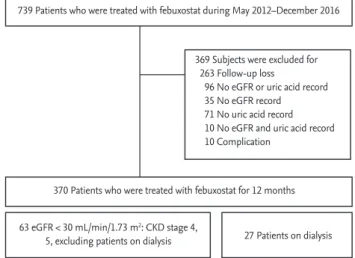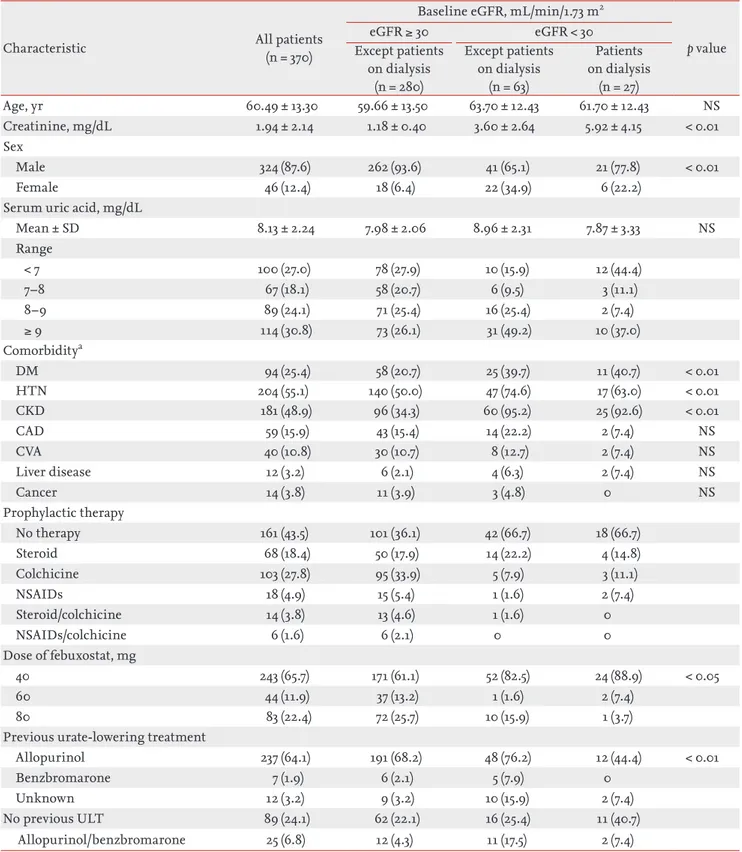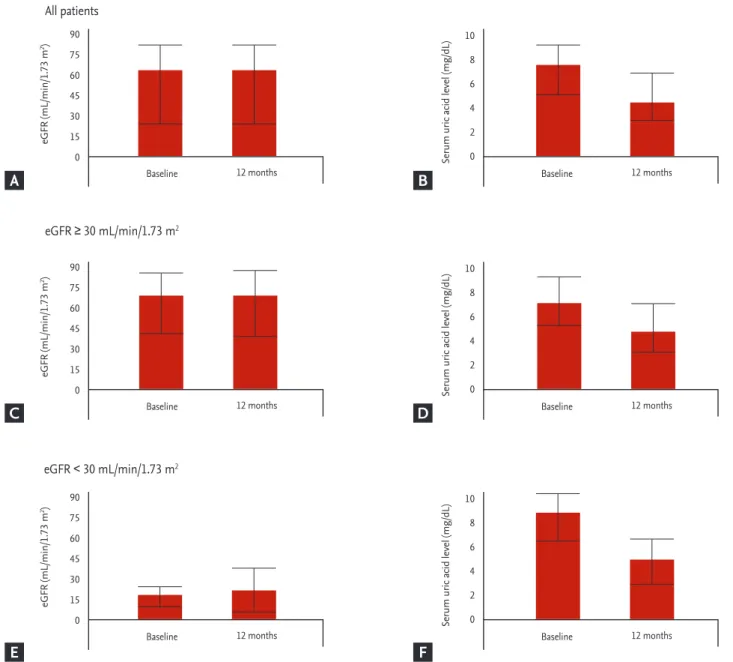Korean J Intern Med 2020;35:998-1003 https://doi.org/10.3904/kjim.2018.423
Division of Rheumatology, Department of Internal Medicine, Keimyung University School of Medicine, Daegu, Korea
Received : November 25, 2018 Revised : February 22, 2019 Accepted : March 12, 2019 Correspondence to Chang-Nam Son, M.D.
Division of Rheumatology, Department of Internal Medicine, Keimyung University School of Medicine, 56
Dalseong-ro, Jung-gu, Daegu 41931, Korea
Tel: +82-53-250-7611 Fax: +82-53-250-7434 E-mail: cnson@kmu.ac.kr
*These authors contributed equally to this work.
Background/Aims: The safety and efficacy of febuxostat in patients with stage 4–5 chronic kidney disease (CKD) are still unclear owing to a lack of studies in these patients. Therefore, we aimed to evaluate the effect of febuxostat on renal func- tion, general safety, and efficacy in gout patients with stage 4–5 CKD.
Methods: Among 739 patients who had been administered febuxostat from May 2012 to December 2016 at a single hospital in Korea, 370 patients who had been monitored for 1 year were analyzed. Serum uric acid levels and estimated glomer- ular filtration rate (eGFR) of patients with gouty arthritis were collected at base- line and 1 year after febuxostat administration.
Results: Among the 370 patients, 280 patients were stage 1–3 CKD, 63 patients were stage 4–5 CKD, and 27 patients were on dialysis. The eGFR of 63 patients with stage 4–5 CKD, excluding dialysis patients, was 19.84 ± 7.08 mL/min/1.73 m2 when they began to take febuxostat and 23.49 ± 16.67 mL/min/1.73 m2 after 12 months (p = 0.13). The urate-lowering effect after 12 months of febuxostat medica- tion showed statistical significance (8.96 ± 2.31 mg/dL at baseline and 4.88 ± 1.68 mg/dL after 12 months, p < 0.01). The difference in incidence of adverse events among patients with stage 1–3 CKD, those with stage 4–5 CKD, and those on dial- ysis was not significant.
Conclusions: Febuxostat demonstrated renal safety and good urate-lowering effi- cacy in gout patients with stage 4–5 CKD, who are not yet on dialysis.
Keywords: Febuxostat; Gout; Renal insufficiency, chronic
Renal safety and urate-lowering efficacy of
febuxostat in gout patients with stage 4–5 chronic kidney disease not yet on dialysis
Sang-Hyon Kim*, So-Yeon Lee*, Ji-Min Kim, and Chang-Nam Son
INTRODUCTION
Gout is a rheumatic disease resulting from the deposi- tion of monosodium urate crystal in joint fluid or soft tissues due to increased levels of serum uric acid (SUA) [1]. Hyperuricemia is caused by an imbalance between uric acid production and excretion. It not only results in gout and kidney failure, but is also a main cause of hypertension and hyperlipidemia. Chronic kidney dis- ease (CKD) causes hyperuricemia, which is a main cause
of gout [2]. Previous studies reported that patients with CKD accounted for 39% of patients with gout [3]. Thus, there has been an increasing interest in lifestyle modifi- cations and pharmacological treatment among patients with hyperuricemia.
Gout management guidelines by the European League Against Rheumatism (EULAR) recommend allopuri- nol, which is metabolized by the kidney, as a first-line urate-lowering drug. As oxypurinol, an active metabolite of allopurinol, can cause several side effects in patients
with CKD, allopurinol dosage should be lowered in pa- tients with CKD depending on their kidney function [4].
In contrast, febuxostat, another urate-lowering agent, is metabolized by the liver. Febuxostat has advantages over allopurinol in that there is no dosage limit associated with renal condition in patients with stage 1–3 CKD [5].
However, as phase 3 clinical trials do not involve pa- tients with stage 4–5 chronic kidney failure, whose glo- merular filtration rate is below 30 mL/min/1.73 m2, the safety and efficacy of febuxostat is unclear in the afore- mentioned patients [6]. This study aims to examine the efficacy and safety of 12-month administration of febux- ostat in patients with stage 4–5 CKD.
METHODS
PatientsAmong 739 in- and outpatients who had been admin- istered febuxostat from May 2012 to December 2016 at a university teaching hospital, 370 patients who had been monitored for 12 months (9 to 15 months) and had their SUA levels and estimated glomerular filtration rate (eGFR) checked before and after taking febuxostat were enrolled in the study. The following patients were excluded: 263 patients who were not monitored during the 12-month period; 96 patients who did not have their glomerular filtration rates and uric acid levels checked
during the 1-year monitoring; and 10 patients who dis- continued febuxostat due to side effects (Fig. 1). This study was conducted under the review of the Institu- tional Review Board at Keimyung University Hospital (IRB no: 2017-01-021). As this is a retrospective study, the need for consent was waived.
Study design
A survey on the basic information (age, gender), SUA, eGFR, serum creatinine levels, comorbidities, types of preventive treatment, febuxostat dosage, and types of urate-lowering agents taken previously was conducted in the enrolled patients (n = 370) at the time of febuxostat initiation. In addition, their SUA levels and eGFR after 12 months (9 to 15 months) of taking febuxostat were de- termined. eGFR were calculated using the Modification of Diet in Renal Disease based on serum creatinine lev- els [7].
Statistical analysis
Results are presented as mean ± SD unless specified otherwise. The Kruskal-Wallis test was used for be- tween-group comparisons. Fisher’s exact test was used to assess the frequencies of gender, underlying disease, types of preventive treatment, and types of urate-lower- ing agents taken previously in between-group compar- isons. A paired t test was conducted to identify changes in SUA levels and eGFR. SPSS for window version 20.0 (IBM Co., Armonk, NY, USA) was used for statistical analysis. A p value less than 0.05 was considered signif- icant.
RESULTS
Baseline characteristics of enrolled subjects
Among a total of 370 patients, Sixty-three patients (mean age, 63.7 ± 12.4 years; male to female ratio, 41:22) had stage 4–5 CKD (Table 1). Mean ± SD serum creatinine and SUA were 3.6 ± 2.6, 9.0 ± 2.3, respectively. Regard- ing comorbidities, 47 had hypertension (74.6%) and 25 had diabetes (39.7%). Preventive treatment was given to 21 patients. Among them, 14 had taken steroids (22.2%), which accounted for the highest number. Regarding the dosage of febuxostat, 48 patients took 40 mg (76.2%), ac- counting for the highest number of patients. Regarding
739 Patients who were treated with febuxostat during May 2012–December 2016
369 Subjects were excluded for 263 Follow-up loss
96 No eGFR or uric acid record 35 No eGFR record 71 No uric acid record 10 No eGFR and uric acid record 10 Complication
63 eGFR < 30 mL/min/1.73 m2: CKD stage 4,
5, excluding patients on dialysis 27 Patients on dialysis 370 Patients who were treated with febuxostat for 12 months
Figure 1. Flow chart illustrating inclusion and exclusion criteria for the study subjects. eGFR, estimated glomerular filtration rate; CKD, chronic kidney disease.
Table 1. Demographic and clinical characteristics of patients
Characteristic All patients
(n = 370)
Baseline eGFR, mL/min/1.73 m2
p value
eGFR ≥ 30 eGFR < 30
Except patients on dialysis
(n = 280)
Except patients on dialysis
(n = 63)
Patients on dialysis
(n = 27)
Age, yr 60.49 ± 13.30 59.66 ± 13.50 63.70 ± 12.43 61.70 ± 12.43 NS
Creatinine, mg/dL 1.94 ± 2.14 1.18 ± 0.40 3.60 ± 2.64 5.92 ± 4.15 < 0.01
Sex
Male 324 (87.6) 262 (93.6) 41 (65.1) 21 (77.8) < 0.01
Female 46 (12.4) 18 (6.4) 22 (34.9) 6 (22.2)
Serum uric acid, mg/dL
Mean ± SD 8.13 ± 2.24 7.98 ± 2.06 8.96 ± 2.31 7.87 ± 3.33 NS
Range
< 7 100 (27.0) 78 (27.9) 10 (15.9) 12 (44.4)
7–8 67 (18.1) 58 (20.7) 6 (9.5) 3 (11.1)
8–9 89 (24.1) 71 (25.4) 16 (25.4) 2 (7.4)
≥ 9 114 (30.8) 73 (26.1) 31 (49.2) 10 (37.0)
Comorbiditya
DM 94 (25.4) 58 (20.7) 25 (39.7) 11 (40.7) < 0.01
HTN 204 (55.1) 140 (50.0) 47 (74.6) 17 (63.0) < 0.01
CKD 181 (48.9) 96 (34.3) 60 (95.2) 25 (92.6) < 0.01
CAD 59 (15.9) 43 (15.4) 14 (22.2) 2 (7.4) NS
CVA 40 (10.8) 30 (10.7) 8 (12.7) 2 (7.4) NS
Liver disease 12 (3.2) 6 (2.1) 4 (6.3) 2 (7.4) NS
Cancer 14 (3.8) 11 (3.9) 3 (4.8) 0 NS
Prophylactic therapy
No therapy 161 (43.5) 101 (36.1) 42 (66.7) 18 (66.7)
Steroid 68 (18.4) 50 (17.9) 14 (22.2) 4 (14.8)
Colchicine 103 (27.8) 95 (33.9) 5 (7.9) 3 (11.1)
NSAIDs 18 (4.9) 15 (5.4) 1 (1.6) 2 (7.4)
Steroid/colchicine 14 (3.8) 13 (4.6) 1 (1.6) 0
NSAIDs/colchicine 6 (1.6) 6 (2.1) 0 0
Dose of febuxostat, mg
40 243 (65.7) 171 (61.1) 52 (82.5) 24 (88.9) < 0.05
60 44 (11.9) 37 (13.2) 1 (1.6) 2 (7.4)
80 83 (22.4) 72 (25.7) 10 (15.9) 1 (3.7)
Previous urate-lowering treatment
Allopurinol 237 (64.1) 191 (68.2) 48 (76.2) 12 (44.4) < 0.01
Benzbromarone 7 (1.9) 6 (2.1) 5 (7.9) 0
Unknown 12 (3.2) 9 (3.2) 10 (15.9) 2 (7.4)
No previous ULT 89 (24.1) 62 (22.1) 16 (25.4) 11 (40.7)
Allopurinol/benzbromarone 25 (6.8) 12 (4.3) 11 (17.5) 2 (7.4)
Values are presented as mean ± SD or number (%).
eGFR, estimated glomerular filtration rate; NS, not significant; SD, standard deviation; DM, diabetes mellitus; HTN, hyper- tension; CKD, chronic kidney disease; CAD, coronary artery disease; CVA, cerebrovascular accident; NSAID, nonsteroidal an- ti-inflammatory drug; ULT, uric acid-lowering treatment.
aTotal subjects (n = 287): GFR ≥ 30 mL/min/1.73 m2 (n = 197), eGFR < 30 mL/min/1.73 m2 (n = 63), patients on dialysis (n = 27).
the types of urate-lowering agents used previously, 34 patients took allopurinol (54.0%), which accounted for the largest percentage.
Safety of febuxostat
The eGFR of 63 patients with stage 4–5 CKD, exclud- ing dialysis patients, were 19.84 ± 7.08 mL/min/1.73 m2 when they began to take febuxostat, and 23.49 ± 16.67 mL/min/1.73 m2 after 12 months (Fig. 2). There was no
significant difference in eGFR before taking febuxostat and after 12 months in all the three groups (all patients, stage 1–3 CKD, and stage 4–5 CKD, respectively). Regard- ing 49 patients with stage 4 CKDexcluding dialysis pa- tients, the eGFR were 22.75 ± 4.80 mL/min/1.73 m2 before taking febuxostat and 22.49 ± 7.93 mL/min/1.73 m2 after taking febuxostat (p = 0.82). In 14 patients with stage 5 CKD, the eGFR were 9.65 ± 3.17 mL/min/1.73 m2 before taking febuxostat and 27.01 ± 32.79 mL/min/1.73 m2 after
Baseline 12 months
eGFR ≥ 30 mL/min/1.73 m2
eGFR < 30 mL/min/1.73 m2 All patients
eGFR (mL/min/1.73 m2) 90 75 60 45 30 15 0
Baseline 12 months
Serum uric acid level (mg/dL)
10 8 6 4 2 0
Baseline 12 months
eGFR (mL/min/1.73 m2) 90 75 60 45 30 15 0
Baseline 12 months
Serum uric acid level (mg/dL)
10 8 6 4 2 0
Baseline 12 months
eGFR (mL/min/1.73 m2) 90 75 60 45 30 15 0
Baseline 12 months
Serum uric acid level (mg/dL)
10 8 6 4 2 0
Figure 2. Changes in estimated glomerular filtration rate (eGFR) and serum uric acid levels after 12 months of febuxostat medication. (A) All patients (n = 370). (B) Baseline eGFR ≥ 30 mL/min/1.73 m2, and not under dialysis therapy (n = 280). (C) Base- line eGFR < 30 mL/min/1.73 m2, and not under dialysis therapy (n = 63).
A
C
E
B
D
F
12 months (p = 0.43). In stage 4–5 CKD, adverse events occurred two cases (66.7%) of myalgia and one case of elevated liver function (33.3%) (Table 2).
Efficacy of febuxostat
In 63 patients with stage 4–5 CKD excluding dialysis, the SUA levels were 8.96 ± 2.31 mg/dL when they began to take febuxostat and 4.88 ± 1.68 mg/dL after 12 months (Fig. 2). In 49 patients with stage 4 CKDexcluding dialy- sis, the SUA levels were 8.78 ± 2.22 mg/dL before taking febuxostat and 5.04 ± 1.69 mg/dL after febuxostat admin- istration (p < 0.01). In 14 patients with stage 5 CKD, the SUA levels were 9.59 ± 2.59 and 4.29 ± 1.58 mg/dL after 12 months (p < 0.01). SUA levels were reduced significantly after 12 months of febuxostat administration in all the three groups (all patients, stage 1–3 CKD, and stage 4–5 CKD, respectively).
DISCUSSION
In this study, we aimed to determine the effect of febux- ostat on renal function, safety, and efficacy in gout pa- tients with stage 4–5 CKD, and found that febuxostat demonstrated renal safety and good urate-lowering ef- ficacy in these patients.
Uric acid is the final metabolite of purine, and ap- proximately 70% of uric acid is excreted in urine. The prevalence of hyperuricemia and gout in patients with CKD is high owing to the reduction in urinary excre- tion of uric acid. The accumulation of uric acid occurs
as a complication of renal failure. It also causes damage in the kidney, which can result in deterioration of renal failure, hypertension, and metabolic syndrome [2].
Although this study was retrospective analysis, ow- ing to a lack of studies of patients with stage 4–5 CKD, it seemed to be valuable. The SUA levels of 63 patients with stage 4–5 CKD excluding dialysis were reduced to 4.88 from 8.96 mg/dL. This finding indicates that febux- ostat is effective for patients with stage 4–5 CKD. Omori et al. [8] reported that febuxostat reduced renal tubular damage and oxidation, thereby preventing endothelio- cyte damage. Thus, febuxostat not only plays a role in efficiently lowering SUA levels in CKD patients, but is also considered an effective agent to prevent deteriora- tion of renal function [9].
Stage 4–5 CKD patients had significant difference in eGFR before and after febuxostat administration. Sakai et al. [10] reported that febuxostat was effective in pa- tients with CKD having hyperuricemia who did not respond to allopurinol treatment. In addition, eGFR increased with febuxostat. Tsuruta et al. [11] conducted a 1-year retrospective study of 73 patients with hyperuri- cemia, and found that the reduction of eGFR was slower in patients who were administered febuxostat than in those who had taken allopurinol.
There are certain limitations to this study. First, being a retrospective study based on medical records, there is a possibility that clinical factors may have been over- looked or underestimated. Second, since the subjects were 370 patients who had been treated at a single insti- tution, the result of the study does not represent all pa- Table 2. Febuxostat complications
Febuxostat complications eGFR ≥ 30 mL/min/1.73 m2 Except patients on dialysis
(n = 516)
eGFR < 30 mL/min/1.73 m2 Except patients on dialysis
(n = 109)
Patients on dialysis
(n = 49)
Total number 15 3 2
Diarrhea 4 (26.7) 0 2 (100.0)
Dermatitis 6 (40.0) 0 0
Musculoskeletal pain and discomfort 2 (13.3) 2 (66.7) 0
LFT rising < 3 × UNL 2 (13.3) 1 (33.3) 0
LFT rising ≥ 3 × UNL 1 (6.7) 0 0
Values are presented as number (%).
eGFR, estimated glomerular filtration rate; LFT, liver function test; UNL, upper normal limit.
tients with gout. Third, the patients had comorbidities, such as hypertension, diabetes, cardiac and cerebrovas- cular diseases, and they had taken different medications before febuxostat administration. Considering these limitations, it is difficult to conclude that changes in SUA levels and eGFR are attributed to a single variable, i.e., febuxostat. Future studies on CKD patients should ensure that the patients have taken the same drug before febuxostat administration to obtain more significant re- search outcomes.
In summary, we found that febuxostat demonstrated renal safety and good urate-lowering efficacy in gout pa- tients with stage 4–5 CKD.
Conflict of interest
No potential conflict of interest relevant to this article was reported.
Acknowledgments
This research was supported by the Keimyung Universi- ty Research Grant of 2016
REFERENCES
1. Richette P, Bardin T. Gout. Lancet 2010;375:318-328.
2. Cirillo P, Sato W, Reungjui S, et al. Uric acid, the met- abolic syndrome, and renal disease. J Am Soc Nephrol
2006;17:S165-S168.
3. Fuldeore MJ, Riedel AA, Zarotsky V, Pandya BJ, Dabbous O, Krishnan E. Chronic kidney disease in gout in a managed care setting. BMC Nephrol 2011;12:36.
4. Richette P, Doherty M, Pascual E, et al. 2016 Updated EU- LAR evidence-based recommendations for the manage- ment of gout. Ann Rheum Dis 2017;76:29-42.
5. Hira D, Chisaki Y, Noda S, et al. Population pharmacoki- netics and therapeutic efficacy of febuxostat in patients with severe renal impairment. Pharmacology 2015;96:90- 98.
6. Schumacher HR Jr, Becker MA, Wortmann RL, et al.
Effects of febuxostat versus allopurinol and placebo in reducing serum urate in subjects with hyperuricemia and gout: a 28-week, phase III, randomized, double-blind, parallel-group trial. Arthritis Rheum 2008;59:1540-1548.
7. Levey AS, Bosch JP, Lewis JB, Greene T, Rogers N, Roth D.
A more accurate method to estimate glomerular filtration rate from serum creatinine: a new prediction equation.
Modification of Diet in Renal Disease Study Group. Ann Intern Med 1999;130:461-470.
8. Omori H, Kawada N, Inoue K, et al. Use of xanthine ox- idase inhibitor febuxostat inhibits renal interstitial in- flammation and fibrosis in unilateral ureteral obstructive nephropathy. Clin Exp Nephrol 2012;16:549-556.
9. Keenan RT, O’Brien WR, Lee KH, et al. Prevalence of con- traindications and prescription of pharmacologic thera- pies for gout. Am J Med 2011;124:155-163.
10. Sakai Y, Otsuka T, Ohno D, Murasawa T, Sato N, Tsuruoka S. Febuxostat for treating allopurinol-resistant hyperuri- cemia in patients with chronic kidney disease. Ren Fail 2014;36:225-231.
11. Tsuruta Y, Mochizuki T, Moriyama T, et al. Switching from allopurinol to febuxostat for the treatment of hy- peruricemia and renal function in patients with chronic kidney disease. Clin Rheumatol 2014;33:1643-1648.
KEY MESSAGE
1. This is a retrospective, observational study con- ducted at a single Korean hospital.
2. Febuxostat showed renal safety and good urate- lowering efficacy in gout patients with stage 4–5 chronic kidney disease.


